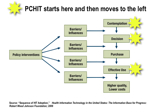Note: This post was previously published, but is being reposted today to tie together the special report, which is now published on this site in its entirety. To see all of the parts together, click on this link.
Welcome
This is a compendium of personas in our health care delivery system. It’s designed to inform individuals and organizations interested in increasing patient and family involvement in all aspects of care, and has been specifically commissioned by the funders of PCHIT.
At the current time, it is estimated that between 3 and 10 % of Americans have access to their care teams through personal health records (PHR). Also at the current time, there are a host of organizations and individuals working to increase this percentage.
Besides being a compendium of organizational personas, Profiles is also an interim status report on the PCHIT initiative. As such, it has a PDCA format.
Plan
A way to visually consider where PCHIT is focusing its efforts is through adaptation of the “Sequence of HIT Adoption” model proposed by the Robert Wood Johnson Foundation (see Electronic Health Records Still Not Routine Part of Medial Practice, Robert Wood Johnson Foundation).
Our plan was to spend time in a cross section of health care, observing the patient-physician interaction. PCHIT was designed to look at factors present in different care environments at the level of the patient-physician interaction. This is based on the concept of Genchi-Genbutsu. This concept is so central to the design of this initiative that we are including an explanation of it here:
First of all, gen means actuality or reality. When we look at the word gen-ba, it means the actual place. In the terms of manufacturing, we can loosely translate this to mean where the work is done. Why is this meaningful? It is not until we understand the other gen words that this begins to make sense.
Second is gen-butsu. Butsu means, the condition of the thing. In terms of manufacturing and considering the word gen-ba, we ask ourselves, “what are the conditions of things in the workplace, where the work is actually done?” The things we are looking for? The condition of the design, the quality, the process, the people, the methods, the equipment, etc. When we think of genba and genbutsu, we are looking to see if the conditions of our standards are deviating in the workplace. This forms the basis for standardization of all aspects in the business.
Third is gen-jitsu. The actual situation. We are looking for facts so that we may understand the gap between reality and standard. We are not looking for what it should be, we know that. We are looking for actual situations, or the facts. This helps us begin to dig for the actual root cause.
If we only consider the standards we tend to sit in a meeting room wondering why the equipment, the people, the materials and processes don’t meet standards. The only way to truly know, is to go to the actual workplace, observe the actual conditions and collect the facts. This leads to true understanding of reality. Otherwise our solutions we invent in the meeting room are for problems that are not really happening in the workplace. This is the reason why problem solving begins with the saying, “go and see for yourself, in the workplace where the work is actually happening.”
We weighted our interest toward organizations with emerging health information technology initiatives, as opposed to mature, or no health information technology initiatives.
We weighted our interest toward organizations serving diverse populations, including under-insured, safety-net, and minority populations (inclusive of federal protected classes as well as gay, lesbian, bisexual, and transgender individuals).
We weighted our interest toward organizations situated geographically in areas served by our sponsors, including New York, California, and District of Columbia.
Kaiser Permanente, a sponsor of this effort, is used here as a benchmark, given its maturity in patient centered health informaiton technology. The same is true for Group Health Cooperative.
Do
Over the next several days, we’ll publish our “Persona” description for key stakeholders in the implementation of patient centered health information technology.
We chose to use the persona concept, established in user interface enginering – you can read a little bit about it here.
Comments are Welcome
Your additional experience, expressed by adding comments on each page of interest, are welcomed


2 Comments
I'm glad you found the genba discussion on the TWI Blog helpful. You may also find of interest the original Training Within Industry materials available in the public domain at http://www.trainingwithinindustry.net. There is an interesting side story related to the crisis of healthcare training in the Red Cross Nurse Training Program during the war. I'm not too up on my healthcare industry history so perhaps some of your readers will find this useful.
Bryan Lund http://www.trainingwithinindustry.blogspot.com
Bryan,
These are great, and I highly recommend people studying health care expertise building review these. I am still half way through "Toyota Talent" – t
Thanks for putting these up for the community,
Ted